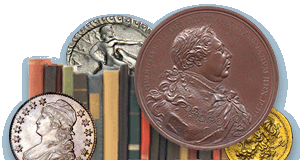
PREV ARTICLE
NEXT ARTICLE
FULL ISSUE
PREV FULL ISSUE
LOOSE CHANGE: SEPTEMBER 14, 2025Here are some additional items in the media this week that may be of interest. -Editor A large hoard of mostly copper 17th-century coins has been unearthed in Poland. -Editor A remarkable discovery was made near the village of Zewierszczów in the Lublin Voivodeship of Poland, when a local metal detectorist came across a hoard of thousands of mid-17th-century coins. The find was uncovered by Grzegorz Panek, a member of the Hrubieszów Historical–Exploration Association "GROSSUS," who has been engaged for years in official searches for objects of historical value under conservation permits. In the process of investigating a strong signal from his detector, Panek unearthed several copper coins near the surface. What at first appeared to be scattered pieces soon revealed itself as part of a very large hoard. Additional coins poured out of the ground as he dug, eventually totaling some 5,000 specimens by estimation. Preliminary analysis suggests that most of the hoard dates from the years 1650–1657, during the reign of King Jan II Kazimierz. Most of the copper coins are so-called "boratynki," small-denomination currency minted in huge numbers for both the Crown and the Grand Duchy of Lithuania. They are named for Tito Livio Burattini, the royal official who organized their minting. Although modest in value in their time and still common among collectors today, the quantity of the find gives researchers a rare window into the circulation of everyday currency in early modern Poland.
To read the complete article, see:
Old-school vending machines are being used to sell mini-artworks. -Editor A small red vending machine, tucked away in a corner of the United States Botanic Garden's gift shop, captivated passersby on a recent humid Sunday afternoon. Two young women stood in front, plopped two tokens into a metal belt, pressed a lever, and watched as a credit-card-sized piece of cardboard slid out. They opened it and found a slip of paper with an illustration of a black swallowtail butterfly. Then they repeated, the second time discovering a print of tomatoes. One of the women, 21-year-old Emily Wartel, said the machine reminded her of 25-cent pencil dispensers in her elementary school. The art vending machine inside the botanic garden is one of hundreds that have popped up across the country over the last few years, as young people search for inexpensive ways to buy and sell original pieces of art. Art vending machines aren't a new concept – they've been around for decades. But with the help of social media, they've begun to captivate a new audience.
To read the complete article, see:
I don't think we've discussed this before - Felix Schlag's grave marker in Oak Hill Cemetery in Owosso, Michigan. Found via the Coin of Note Newsletter #55. Thanks! -Editor Sculptor. He is best remembered as the designer of the US Jefferson nickel that was circulated from 1938 through 2003. Born in Frankfurt, Germany exhibited a great talent for the arts and had become quite experienced throughout his childhood, winning many art competitions and contests in Europe. When World War I broke out in Europe in July 1914 he served in the German Army. After the war he worked as medalist, sculptor, and designer. In 1929 he and his family immigrated to the US and he obtained a job with General Motors, where he actually designed and stylized classic automobiles. In the 1930s he moved to Chicago, Illinois where he was commissioned to work on designing sculptures in prominent public locations inside the city.
To read the complete article, see:
Wayne Homren, Editor The Numismatic Bibliomania Society is a non-profit organization promoting numismatic literature. See our web site at coinbooks.org. To submit items for publication in The E-Sylum, write to the Editor at this address: whomren@gmail.com To subscribe go to: Subscribe All Rights Reserved. NBS Home Page Contact the NBS webmaster 
|



